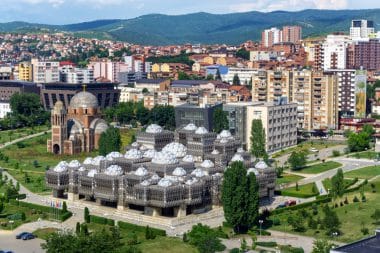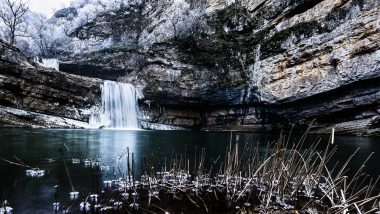Kosovo, which became independent from Serbia in 2008, is the youngest state in Europe. In contrast to other so-called Western Balkan countries such as Montenegro, Serbia, Croatia or Bosnia and Herzegovina, Kosovo is not necessarily a well-known holiday destination. But that was about to change, as there are fabulously beautiful natural landscapes and traditional cities to discover here. In addition, Balkan cuisine also tastes good in Kosovo with the hearty paprika paste ajvar and delicious grilled specialties such as Qebapi, as well as the national dish Fli: a pancake prepared for hours over an open fire with lots of cream.
Prishtina: the youngest capital in Europe

At first glance, Prishtina is not exactly a pearl among Europe’s capitals. With 145,000 inhabitants, the largest city in Kosovo is located in the heart of the country, which is only about 11,000 square kilometers in size. Traditional buildings in the city often had to make way for socialist functional buildings under Tito. Nevertheless, it is worth taking a walk through the bazaar, which is now a little away from the city center. Here, some very interesting historical buildings are grouped around the lively market hustle and bustle, such as the Jasār Pasha Mosque and the Llap Mosque. The latter burned down in the Kosovo war, but was rebuilt. The Sultan Mehmet II al-Fātih Mosque dates back to the 15th century and is located right next to the Kulla e Sahatit, the 19th-century clock tower. The 26-metre-high tower, built of sandstone and brick, was a reminder of the city’s Ottoman heritage. In the center is the Catholic Mother Teresa Cathedral, which was completed in 2007.
From the 70-metre-high bell tower, you have a magnificent view over Prishtina, all the way to the Sharr Mountains, which form the border with North Macedonia. Directly opposite is probably the most striking building in the capital: the National Library, built in 1982. The building, which is girded by a metal grille and has 99 balloon-like glass domes in the roof construction, looks very futuristic. On the green area next to the National Library is the ruins of the Serbian Orthodox Church of Christ the Saviour, which was never completed. At the outbreak of the Kosovo war, it was still unfinished. After that, its construction was stopped, as the Kosovars perceive the church as a symbol of the oppression of their ethnic group by the Serbian Milošević regime. Between all these buildings, Prishtina pulsates with joie de vivre. There are a number of stylish bars, clubs and cafés where you can party.
A melting pot of cultures
Prishtina is a place where many cultures meet. The city’s history dates back to ancient times, and over the centuries it has been under Byzantine, Ottoman and Yugoslav rule. This multi-layered past is reflected in the city’s architecture and cultural customs. The Ottoman architecture in particular is still visible in many parts of the city, such as the impressive İmperial Mosque from the 15th century.
Modern and traditional cuisine
The culinary scene in Prishtina is a reflection of its cultural diversity. Traditional Kosovar restaurants offer local delicacies such as Pljeskavica, Burek and Ajvar. In addition, you will find modern cafés and restaurants offering international cuisine. The city is also known for its vibrant café culture, which combines European influences with local traditions. A visit to one of the many teahouses serving traditional Kosovar macchiato is a must for any visitor.
Art and culture
The cultural heart of the city beats in its numerous museums, galleries and theatres. Kosovo National Theatre and National Museum of Kosovo are just two of the cultural highlights Prishtina has to offer. The annual Prishtina International Film Festival attracts artists and visitors from all over the world and has become an important event in the international cultural calendar.
Nightlife and events
Prishtina is known for its vibrant nightlife. The city offers a variety of bars, clubs and live music venues that are open until the early hours of the morning. The nightlife is heavily influenced by the city’s young population and offers an energetic and youthful atmosphere.
Arrival and best time to travel
Prishtina can be reached via Prishtina International Airport, which offers regular connections to many major European cities. The city can also be reached by land routes from neighboring countries. Spring and autumn are ideal times to visit, when the weather is mild and the city is full of life.
Prishtina is a city that combines tradition and modernity in a lively mix, enchanting visitors with its unexpected beauty and dynamism. Each visit to this charming city offers new discoveries and the opportunity to dive deep into the soul of modern Kosovo.
Prizren: Kosovo’s Ottoman beauty

In the south of the country, Prizren is the second largest, and, probably also, most beautiful city in Kosovo. The historic city center is Ottoman. Many buildings date back to the Middle Ages. The city’s landmark is the Ottoman stone bridge, which connects the traditional districts of Prizren. High above the city is the fortress from the 11th century, from which you can enjoy a magical view of the old town – especially in the evening hours. Furthermore, the cityscape is characterized by numerous mosques. The Serbian Orthodox Bogorodica Ljeviška, which was built on the foundation of a Byzantine basilica from the 11th century, is also striking. In the Archaeological Museum, which is housed in a former hammam from the 15th century, you can see archaeological finds from the immediate vicinity of Prizren.
Often referred to as the cultural heart of Kosovo, Prizren is a city that stands out for its historic architecture, lively festivals and welcoming hospitality of its inhabitants. Located at the foot of the Sharr Mountains, this picturesque town offers a unique blend of history, culture, and stunning nature that makes it an ideal destination for travelers looking to explore the unknown.
Historical wealth in every corner
The history of Prizren goes back a long way, and the city served as an important trade and cultural hub during the Byzantine Empire and Ottoman rule. The city’s landmark, the Prizren Fortress, towers majestically above the red roofs and offers spectacular views over the valley and rivers that surround the city. A walk through the stone-paved city center leads past the Sinan Pasha Mosque and the 14th-century Church of St. Mary, which are a testament to the city’s religious and architectural diversity.
Experience cultural diversity
Prizren is known for its ethnic and cultural diversity. Albanians, Serbs, Bosniaks and Turks live here in a community known for its multiculturalism. This diversity is also reflected in the city’s gastronomy. Visitors can look forward to a range of taste experiences, from traditional Kosovar dishes such as burek and ćevapi to Turkish coffee and sweet baklavas.
Festivals and events
A highlight in Prizren’s calendar of events is the annual Dokufest, an international documentary and short film festival that attracts filmmakers and art enthusiasts from all over the world. The festival uses the city’s historic sites as backdrops for film screenings and discussions, creating a fascinating combination of ancient architecture and modern cinematic art.
Natural
For nature lovers, Prizren and its surroundings offer numerous opportunities for outdoor activities. The Sharr Mountains are a paradise for hikers, skiers and botany fans. The mountain landscapes are rich in flora and fauna and offer excellent conditions for skiers and snowboarders in winter in ski resorts such as Brezovica.
Arrival and best time to travel
Prizren is easily accessible via Pristina International Airport, which is about a 90-minute drive away. A well-developed bus network connects Prizren with the capitals of the Balkans. The best time to visit is between spring and early autumn, when the weather is ideal for exploring the city and hiking in the mountains.
Coming together in Prizren means diving into the depths of a rich history, being enchanted by the cultural diversity and getting lost in the breathtaking nature. A visit here is unforgettable and makes you curious about more discoveries in Kosovo.
The natural wonders of the Rugova Gorge
In the west of Kosovo, near the city of Peja, you will find the Rugova Gorge, which is no less than 25 kilometres long. The surrounding mountains, known as the Albanian Alps, are wonderful for hiking. The spectacular and challenging long-distance hiking trail Peaks of the Balkans starts or ends here: depending on the direction in which you want to walk the hiking trail, which leads through three Balkan states. The villages in the Rugova Valley, located between waterfalls, lakes and high mountain peaks, are still very original. The people there like to spontaneously invite hikers for a coffee in their garden, because hospitality is very important everywhere in Kosovo. If you are in the area, it is definitely worth visiting the Serbian Orthodox Patriarchal Monastery Peć. The bright red monastery contains impressive frescoes and icons, and is a UNESCO World Heritage Site.
Natural spectacle around the Mirusha Waterfalls

Right in the middle between Kosovo’s three largest cities, Prishtina, Peja and Prizren, lies Mirusha Park. The Mirusha Waterfalls are a conglomerate of 16 waterfalls spread over an area of ten kilometers in a gorge. A hiking tour through this area is a wonderful nature experience, especially in summer. On the way you pass an additional 13 lakes. The flora and fauna in Mirsuha Park is also more than striking. Hungarian oaks in particular can be found here: in between there are 330 different vascular plant species, i.e. ferns and grasses as well as mosses. More than 40 species of mushrooms have been counted in the nature reserve so far. If you are lucky, you will also meet wildcats, badgers and turtles on your hike.
Cave adventure in the Shpella e Gadimës
The Shpella e Gadimës, in German, the stalactite cave Gadime, is located near the small town of Lipjan, about 20 kilometers from the gates of the capital Prishtina. In 1966, the cave was discovered and opened to visitors. In total, the stalactite cave is 1,260 meters long. Interested parties can visit a 500-meter-long passage of the entire cave. This is surrounded by impressive stalactites, stalagmites and aragonites. The cave walls shimmer colorfully and in the middle of the cave is the so-called Glückssee. Anyone who throws in small change is allowed to make a wish.
The small but fine Gjakova
Directly on the border with Albania lies the city of Gjakova, which is inhabited by almost 40,000 inhabitants. Founded in the 15th century, the city still has many historic buildings from that time. With 33 mosques, a well-preserved historic bazaar, many half-timbered houses, an Ottoman clock tower and the stone Tanner’s Bridge, there is much to see in Gjakova. In the city’s Ethnographic Museum, visitors can learn all about the traditional way of life and history of the Kosovo Albanians. In addition to household items and traditional costumes, old furniture and peculiar musical instruments are on display. Gjakova is part of a rich Kosovar music and dance tradition. Near the city, the 900-metre-long Drin Gorge, which is surrounded by spectacular rocks, beckons.


